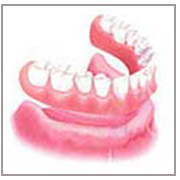


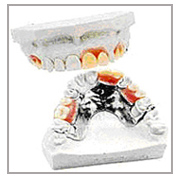

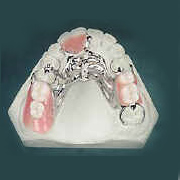
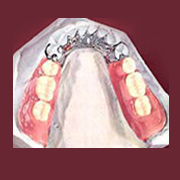

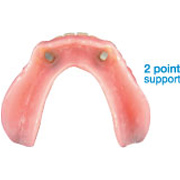


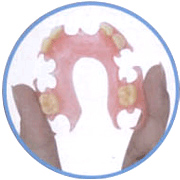

Complete dentures or Full dentures are used when all the teeth are missing . Complete dentures can be either "conventional" or "immediate". The framework of complete dentures may be made of resin, metal or a combination.
Implant supported overdentures are an alternate to conventional dentures whereby a full dentures is placed over the dental implants with metal bar/balls that gives better retention.
A removable partial denture usually consists of replacement teeth attached to a pink or gum-colored plastic base, which is connected by metal clasps or precision attachments that holds the denture in place in the mouth. Precision attachments are generally more esthetic than metal clasps and they are nearly invisible.
Conventional Dentures are made after the teeth have been removed and the gum tissue has begun to heal. Conventional dentures is ready for placement in the mouth about 8 to 12 weeks after the teeth have been removed.
Immediate dentures are made in advance and can be positioned as soon as the teeth are removed. As a result, the wearer does not have to be without teeth during the healing period. However, bones and gums shrink over time, especially during the healing period following tooth removal therefore immediate dentures would usually require more adjustments to fit properly during the healing process and generally should only be considered a temporary solution until conventional dentures can be made. The healing process as it can take months for your bone and tissue to stabilize after tooth extractions.
Recovery from getting dentures may be a two-step process. If extractions are necessary, patients can expect the recovery of their gums to take up to 4 weeks or longer.
Once healed and the dentures are placed, the patient will need time to adjust to the new teeth. While patients can speak normally within a few hours, they may experience minor discomfort when eating or chewing. This discomfort may last from several days to a few weeks until the muscles of your cheek and tongue learn to keep them in place and you get comfortable inserting and removing them. It is recommended that patients with new dentures eat soft foods until they become comfortable with chewing.
it is not unusual for minor irritation or soreness to occur and for saliva flow to increase when you first start wearing dentures, but these problems will diminish as your mouth adjusts to the new denture.
When it comes to dentures the most common source of agony is a bad fit. It's something that's hard to avoid since your gums are between a rock and a hard place. The rock is your jawbone, and that hard place is the hard acrylic liner that holds the prosthetic teeth.
While some people can wear dentures without a single complaint, most denture wearers feel some discomfort while chewing foods. Even slight shifts back and forth can translate into serious gum problems over time. Reasons for discomfort and denture misfit are related to the ever-changing conditions in the mouth. As you age, gum tissue shrinks along with the jawbone. Hard dentures don't adjust to new shapes and hence most long-time denture wearers end up using some form of adhesive to increase stability while wearing their dentures.
There's now a new wave of soft dentures, or flexible dentures, that promise to eliminate the problems associated with hard acrylic liners. They require no adhesives, will adjust to irregularities in your mouth, and stay in place even under harsh chewing conditions.
The secret to these soft dentures is the undercut of the gum ridge. Flexible dentures hook into these undercuts to provide the stability needed to eat tough foods like apples and even hard nuts. A flexible denture is really just a traditional denture with a flexible resin coating as the last inner coating. It's the flexible resin that locks into your undercuts and acts as a buffer between your gums and the hard base. More flexibility can be added by constructing the entire denture out of this flexible material.
These flexible resins are more expensive but also longer-lasting than your traditional soft liner. However, the material used happens to be non-porous so that no bacteria can build up within it. Even though it's non-porous it can retain a small percentage of water to help interface with adjacent tissues.
Another advantage to a soft denture is that the trial fitting can be used as part of the final denture, meaning that the overall production time of a soft denture is shorter than that of a hard acrylic denture.
If you're tired of the pains of wearing a hard denture, consider talking to your dentist about the possibility of a completely soft and flexible denture. Though it is not for every patient, it's worth looking into because the results can often make a world of a difference.
